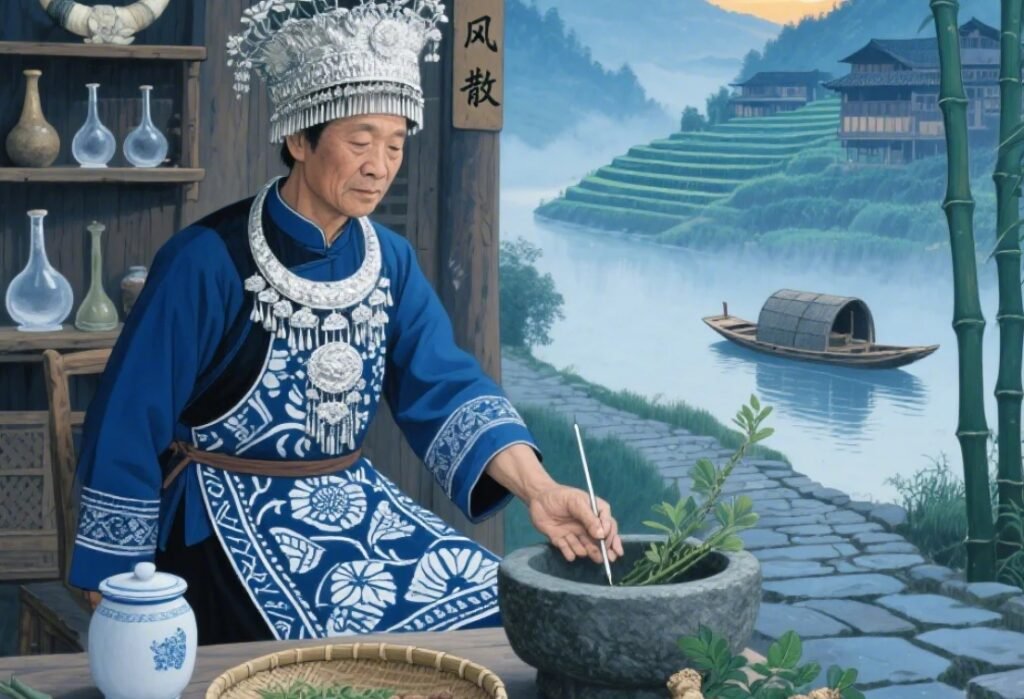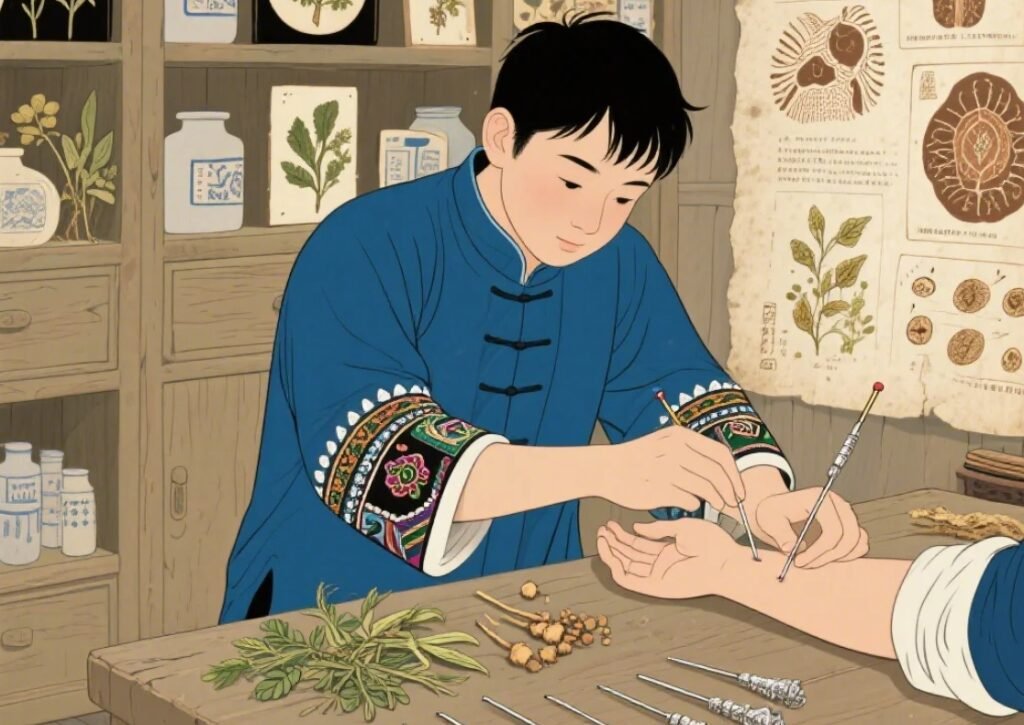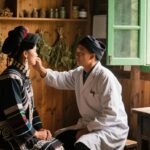Anwo (Cough)
In Miao medicine, cough is categorized into three types: Dahe (externally contracted cough), Jiyangying·Anwo (internally induced cough), and Fengle Pumeng·Anwo (lung-origin cough).
I. Dahe (Cough due to External Pathogenic Invasion)
Overview
In Miao medicine, coughs triggered by external causes are referred to as Dahe. This condition arises when the lung qi ascends forcefully, producing coughing sounds and phlegm expulsion. The nature of this condition is similar to what Traditional Chinese Medicine (TCM) describes as “cough from external contraction.”
In TCM theory, such coughs are primarily caused by the invasion of six external pathogenic factors—wind, cold, summer-heat, dampness, dryness, and fire—entering the body through the mouth, nose, or skin, which then affect the lungs. This impairs the dispersing and descending functions of the lungs, causing reversed qi movement and subsequent coughing. Additionally, exposure to smoke, dust, or harmful gases may disturb lung function, leading to cough.
From a Western medical perspective, conditions like upper respiratory tract infections, acute or chronic bronchitis, bronchiectasis, chronic pharyngitis, and pneumonia—where cough is the primary symptom—can be evaluated and treated under this category in Miao medical diagnostics.
Huhou Jipeng · Miao Disease Classification
According to Miao medical theory, Dahe is considered a minor illness. It is further divided into two subtypes: Heat-Channel Wind-Heat Cough and Cold-Channel Wind-Cold Cough.
Aijiangduo · Etiology
Externally contracted cough typically results from exposure to wind-cold or heat-toxin.
Gengduomeng · Pathogenesis
The root causes of externally contracted cough often include overwork, which weakens the lung’s defensive capacity; improper daily routines; or sudden climatic changes, during which wind pathogens may invade the body through the mouth, nose, or skin. Inhalation of smoke, foul air, or chemical irritants can also obstruct the lung qi and cause dysfunction. Miao medicine notes that pathogenic factors vary by season. Generally, daytime coughing is associated with phlegm in the lungs, whereas nighttime coughing is linked to internal heat in the lungs.
Key Points for Diagnosis
Diagnostic Criteria
(1) Marked coughing with phlegm, often accompanied by an itchy throat.
(2) Acute onset with a short disease course, usually accompanied by symptoms of external contraction.
Relevant Examinations
Commonly seen in upper respiratory infections, acute bronchitis, and pneumonia. Diagnosis can be supported by reviewing medical history and conducting routine blood tests, erythrocyte sedimentation rate (ESR), sputum culture, and chest X-ray.
Differential Diagnosis
Guojingsha (Common Cold)
Both conditions fall under externally contracted diseases. In Miao medicine, colds result from the invasion of wind, cold, or heat toxins. Anwo (cough) is primarily caused by the upward disturbance of lung qi, leading to cough and sputum. While coughing may also occur with a common cold, more prominent symptoms include nasal congestion, runny nose, sneezing, throat itch or pain, headache, joint pain, chills, or fever.
Jiyangying·Anwo (Internally Induced Cough)
This refers to a cough that occurs when there is already an underlying internal condition, which becomes activated by external pathogens, leading to a recurrence of symptoms.
Pattern Classification and Treatment
1. Heat-Channel Wind-Heat Cough
Mengliduo (Symptoms): Head and body ache, aversion to wind, general fever, aching limbs, cough, heavy breathing, loud coughing sounds, dry sore throat, thick and sticky sputum, and sweating during coughing.
Xingleng (Channel Affiliation): Belongs to the Heat Channel category.
Jiahemeng (Treatment Principle): Disperse wind-heat, ventilate the lungs, and suppress cough.
Ouduoxi Jia·Gang’ou (Prescription & Explanation):
Zhidou Wogang (Folium Mori, mulberry leaf) 12g
Bangwuwu (Flos Chrysanthemi Indici, wild chrysanthemum) 10g
Woke’ou (Herba Menthae, mint) 6g
Zubieba (Radix Peucedani, Peucedanum root) 10g
Woxiangxue (Fructus Arctii, burdock fruit) 15g
Boil the above ingredients and take as a decoction.
Medicinal Functions:
Folium Mori (Zhidou Wogang, sangye, sangye): bitter, cold; clears heat, dispels wind, moistens the lungs, and eliminates dampness.
Flos Chrysanthemi Indici (Bangwuwu, yejuhua, yejuhua): bitter, cold; clears heat and detoxifies.
Herba Menthae (Woke’ou, bohe, bohe): pungent, cold; clears heat and benefits the throat.
Radix Peucedani (Zubieba, qianhu, qianhu): bitter, slightly pungent, cold; clears heat and dissolves phlegm.
Fructus Arctii (Woxiangxue, niubangzi, niubangzi): bitter, cold; disperses lung qi and relieves cough.
Pharmacological Effects of Each Herb:
Mulberry Leaf (Sangye): Cold in nature and bitter in taste; clears heat, dispels wind, moistens the lungs, and eliminates dampness.
Wild Chrysanthemum (Yejuhua): Cold in nature and bitter in taste; clears heat and detoxifies.
Mint ( Bohe): Cold in nature and pungent in taste; clears heat and benefits the throat.
Radix Peucedani (Qianhu): Cold in nature, bitter and slightly pungent in taste; clears heat and resolves phlegm.
Fructus Arctii (Niubangzi): Cold in nature and bitter in taste; disseminates lung Qi and relieves cough.
1. Cold Meridian Wind-Cold Cough
Menglide (Symptom Manifestation): Cough with thin, white sputum; shortness of breath; clear nasal discharge; soreness in the limbs; chills and fever without sweating; headache; and clear, long urination.
Xingleng (Affected Meridian): Belongs to cold meridian cold-type disease.
Jiahemeng (Treatment Principle): Release the exterior and disperse cold, clear the lungs and relieve cough.
Ouduo Xijia, Gang’ou (Prescription and Explanation):
Gahuilei (Ephedra, Mahuang) 10g
Zhenmang (Apricot Kernel, Xingren) 12g
Egeigeba (Platycodon Root, Jiegeng) 10g
Zubieba (Radix Peucedani, Qianhu) 15g
Jiabiliji (Fissistigma oldhamii, Bazhaojinlong) 15g
Liuxigengli (Pericarpium Citri Reticulatae, Chenpi) 10g
Decoction for oral administration.

Pharmacological Effects of the Herbs:
Ephedra (Mahuang): Warm in nature and pungent in taste; induces sweating to release the exterior, disseminates lung Qi and relieves cough.
Apricot Kernel (Xingren): Cold in nature, bitter and slightly toxic; moistens the lungs and stops coughing.
Platycodon Root (Jiegeng): Neutral in nature, bitter and slightly pungent; disseminates lung Qi, benefits the throat, eliminates phlegm and discharges pus.
Radix Peucedani (Qianhu): Clears heat and resolves phlegm.
Fissistigma oldhamii ( Bazhaojinlong): Clears heat and benefits the throat, reduces swelling.
Pericarpium Citri Reticulatae (Chenpi): Warm in nature, pungent and bitter; transforms phlegm and relieves cough.
II. Jiyangying·Anwo (Internally-Induced Cough)
[Overview]
In Miao medicine, a cough caused by internal injury is referred to as Jiyangying·Anwo. This refers to a condition where a person already has an underlying illness, and the current cough is triggered by an invasion of external pathogenic factors. In Traditional Chinese Medicine (TCM), internally-induced cough is considered to result from dysfunction of internal organs or invasion of internal pathogens affecting the lungs. This includes cases where other organ disorders affect the lungs or where the lungs themselves are diseased.
In Western medicine, chronic bronchitis, pulmonary tuberculosis, cor pulmonale, lung cancer, and other diseases with cough as the primary symptom may be referenced in this context.
[Huhou Jipeng·Miao Medical Classification]
Jiyangying·Anwo is considered a minor syndrome and is classified into “cold-type internally-induced cough” and “heat meridian heat-toxin cough.”
[Aijiangduo·Etiology]
Usually caused by damage to the lungs due to other illnesses, which then induces a cough.
[Gengduomeng·Pathogenesis]
On the basis of a pre-existing illness, external pathogenic factors such as wind, heat, and dampness invade the body, impairing lung function and depleting qi and blood, resulting in a cough. Manifestations include disrupted qi movement, heat rising with blood, and copious sputum that is difficult to expectorate. In severe cases, sputum may be blood-streaked.
[Diagnostic Key Points]
1. Diagnostic Criteria
(1) Cough with audible sound and sputum production, itchy throat.
(2) Usually chronic and recurrent, with a prolonged course, and often accompanied by symptoms of other organ disorders.
2. Related Examinations
Commonly seen in chronic bronchitis, tuberculosis, cor pulmonale, lung cancer, etc. Clinical examinations may include patient history, complete blood count, erythrocyte sedimentation rate, sputum culture, chest X-ray, etc.
[Differential Diagnosis]
Anwo (Externally-Induced Cough): Mostly caused by external wind-cold or heat-toxin invading the lungs; usually has a short course.
Jiyangying·Anwo (Internally-Induced Cough): Occurs on the basis of chronic illness, triggered again by external factors; tends to be chronic and persistent.
[Classification and Treatment Based on Syndrome Differentiation]
1. Cold-Type Internally-Induced Cough
Menglide (Symptom Manifestation): Recurrent cough with a deep voice, copious and sticky sputum, relief after expectoration, often worsens in the morning or after meals.
Xingleng (Affected Meridian): Belongs to heat meridian heat-type disease.
Jiahemeng (Treatment Principle): Activate blood circulation, resolve blood stasis, clear the lungs, and relieve cough.
Ouduo Xijia, Gang’ou (Prescription and Explanation):
Kela (Prepared Pinellia, Zhibanxia) 10g
Woruiliu (Elephantopus scaber, Yuqiuchuan) 15g
Wole (Clerodendrum cyrtophyllum, Zhizhuxiang) 12g
Oudi (Perilla Leaf, Zisu) 8g
Decoction for oral administration.
Pharmacological Effects of Each Herb:
Prepared Pinellia (Zhibanxia): Warm in nature and pungent in taste; dries dampness and transforms phlegm.
Elephantopus scaber (Yuqiuchuan): Cold in nature and bitter in taste; clears heat and stops cough.
Clerodendrum cyrtophyllum (Zhizhuxiang): Warm in nature and bitter-pungent in taste; dispels wind, detoxifies, regulates qi, and relieves pain.
Perilla Leaf (Zisu): Warm in nature and pungent in taste; descends rebellious qi, benefits the lungs, resolves phlegm, and harmonizes the middle burner.
2. Heat Meridian Heat-Toxin Cough
Menglide (Symptom Manifestation): Cough with yellow, sticky, and hard-to-expectorate sputum; dry and sore throat; often accompanied by aversion to wind, fever, headache, body aches, yellow nasal discharge, and thirst.
Xingleng (Affected Meridian): Belongs to heat meridian heat-type disease.
Jiahemeng (Treatment Principle): Disperse wind-heat, release the lung, and stop cough.
Ouduo Xijia, Wang’ou (Prescription and Explanation):
Zhidouwugang (Mulberry Leaf, Sangye) 15g
Woke’ou (Mint, Bohe) 8g
Zhenmang (Apricot Kernel, Xingren) 10g
Jiangjia’edong (Ophiopogon Root, Maidong) 12g
Douwobo (Lycium Root Bark, Digupi) 12g
Decoction for oral administration.
Pharmacological Effects of Each Herb:
Mulberry Leaf (Sangye): Clears heat and moistens the lungs.
Mint (Bohe): Clears the throat and disperses heat.
Apricot Kernel (Xingren): Moistens the lungs, relieves cough, and calms wheezing.
Ophiopogon Root ( Maidong): Nourishes yin and moistens the lungs.
Lycium Root Bark ( Digupi): Clears lung heat, cools the blood and stops bleeding, generates body fluids and quenches thirst, detoxifies and reduces swelling.
III. Fenglepumeng·Anwo (Lung-Origin Cough)
[Overview]
In Miao medicine, lung-origin cough falls under the category of Fenglepumeng·Anwo, which is equivalent to the “externally-contracted cough” described in Traditional Chinese Medicine (TCM). TCM views lung-origin cough as a chronic pulmonary disorder characterized by rebellious lung qi, leading to repeated and persistent coughing.
In Western medicine, this condition correlates with symptoms of acute and chronic bronchitis, emphysema, and cor pulmonale, often presenting with cough and dyspnea as key clinical signs.
[Huhou Jipeng·Miao Medical Classification]
In Miao medicine, Fenglepumeng·Anwo is considered a broad category of lung-related cough, and is further classified into four subtypes: wind-heat-toxin cough, cold-toxin cough, heat-syndrome cough, and phlegm-damp-cold-toxin cough.
[Aijiangduo·Etiology]
This disease mainly arises from the invasion of external pathogenic factors such as wind-toxin, cold-toxin, and heat-toxin. Most patients have poor constitution or suffer from chronic respiratory diseases. Once triggered by external pathogens, it easily leads to coughing and expectoration.
[Gengduomeng·Pathogenesis]
When pathogenic wind, cold, or heat invade the body—especially in individuals with weak constitution or underlying illnesses—they cause injury to qi and blood, block the meridians, and obstruct the normal flow of qi. This results in dysfunction of the lung’s dispersing and descending functions, leading to symptoms such as coughing and wheezing. If the pathogenic toxins transform into heat, they may increase phlegm production and aggravate the condition.
[Diagnostic Key Points]
1. Diagnostic Criteria
(1) Usually has a history of chronic pulmonary diseases, with recurrent attacks and slow recovery, commonly seen in the elderly.
(2) Episodes are often triggered by invasion of external pathogens, but may also be induced by overexertion or emotional disturbances.
2. Related Examinations
(1) X-ray Examination: Shows increased lung translucency, thickened and disordered lung markings.
(2) Electrocardiogram (ECG): Right ventricular hypertrophy, right axis deviation, clockwise rotation, P-pulmonale.
(3) Arterial Blood Gas Analysis: Hypoxemia or combined carbon dioxide retention.
(4) Blood Tests: Increased red blood cells and hemoglobin, elevated whole blood and plasma viscosity, elevated white blood cell count with increased neutrophils. In late stages, liver and kidney dysfunction and electrolyte imbalances may occur.
[Differential Diagnosis]
1. Guojingshe (Common Cold)
Both are externally contracted diseases. Miao medicine considers Guojingshe to be caused by wind-heat-toxin, and although coughing may be present, the primary symptoms include nasal congestion, runny nose with clear mucus, sneezing, itchy and sore throat, headache, body aches, aversion to wind and cold, and fever. In contrast, Anwo is mainly characterized by rebellious lung qi, coughing, and sputum production.
2. Jiyangying·Anwo (Internally-Induced Cough)
Jiyangying·Anwo refers to latent internal pathogenic factors that are triggered by external stimuli. Fenglepumeng·Anwo, on the other hand, is caused by external wind, cold, and heat toxins invading the lungs, leading to qi and blood injury, meridian obstruction, and failure of lung qi dispersal.
[Classification and Treatment]
1. Wind-Heat-Toxin Cough Type
Menglide (Symptom Manifestation):
Coughing with yellow phlegm or sticky sputum that is hard to expectorate, dry throat, sore throat, aversion to wind, fever, headache, body aches, yellow nasal discharge, thirst, etc. Pulse is large and rapid.
Xingleng (Affected Meridian):
Belongs to heat meridian heat-type disease.
Jiahemeng (Treatment Principle):
Dispel wind and clear heat, detoxify, resolve phlegm, and stop coughing.
Ouduo Xijia, Wang’ou (Prescription and Explanation):
Wozubieba (Cynanchum atratum, Baiwei) 10g
Zhenmang (Apricot Kernel, Xingren) 10g
Egeigeba (Platycodon Root, Jiegeng) 12g
Deli (Stemona Root, Baibu) 10g
Wojiubiyou (Yiduoyun) 10g
Decoction for oral administration.

Pharmacological Effects of Each Herb:
Cynanchum atratum (Baiwei): Cold in nature, bitter with slight pungency; disperses wind-heat, descends qi, and resolves phlegm.
Apricot Kernel (Xingren): Cold in nature and bitter, slightly toxic; relieves cough and calms wheezing.
Platycodon Root (iegeng): Cold in nature, bitter and pungent; promotes lung qi circulation and expels phlegm.
Stemona Root (Baibu): Cold in nature, bitter and sweet; moistens the lungs, stops cough, and resolves phlegm.
Yiduoyun (Wojiubiyou): Warm in nature, sweet and bland; moistens the lungs and relieves cough.
1. Cold Toxin Cough Type
Menglido (Symptoms): Harsh cough with white, watery phlegm, itchy throat, nasal congestion, clear nasal discharge, headache, body aches, chills and fever, absence of sweating, etc. Pulse: small and slow.
Xingleng (Syndrome category): Cold syndrome of the cold meridian.
Jiahemeng (Treatment principle): Disperse wind and cold, moisten the lungs and relieve cough.
Ouduo Xijia, Gang’ou (Prescription and explanation):
Medicinal Properties:
Zisu leaf: Hot in nature, sweet and pungent, mildly toxic; warms the lungs, disperses cold, relieves cough and asthma.
Apricot kernel (Xingren): Moistens the lungs and relieves cough.
Tiaoye Xixin: Hot, pungent, mildly toxic; warms the lungs and resolves phlegm.
Baichuan and Jiegeng: Cold in nature; disperse the lungs, relieve cough, and expel phlegm.
Fuling: Warm and sweet; promotes urination, strengthens the spleen, and calms the mind.
Gaooudi (Perilla leaf, Zisu leaf) 8g
Xingren (Apricot kernel, Xingren) 6g
Jiabanggang (Asarum forbesii, Tiaoye Xixin) 6g
Baichuan (Cynanchum atratum, Baichuan) 10g
Jiegeng (Platycodon root, Jiegeng) 10g
Baojiang Geida (Poria, Fuling) 10g, decoct and take.
2. Heat Syndrome Cough Type
Menglido (Symptoms): Cough with shortness of breath, yellow and thick sputum with foul smell, occasional hemoptysis, chest pain, facial flushing, fever, dry mouth, thirst, etc. Pulse: large and rapid.
Xingleng (Syndrome category): Cold syndrome of the cold meridian.
Jiahemeng (Treatment principle): Clear heat, moisten the lungs, stop cough, resolve phlegm.
Ouduo Xijia, Wang’ou (Prescription and explanation):
Bangjiqiang (Honeysuckle flower, Jinyinhua) 15g
Wohui Wofei (Dandelion, Pugongying) 15g
Chonggang (Hedyotis diffusa, Baihuasheshecao) 10g
Baibu (Stemona root, Baibu) 10g
Baichuan (Cynanchum atratum, Baichuan) 10g
Pandou (Mahonia bealei, Shidagonglao) 10g, decoct and take.
3. Phlegm-Damp Cold Toxin Cough Type
Menglido (Symptoms): Acute onset with fever and sweating, excessive sputum that is sticky or clumpy, white or grayish in color, chest tightness and shortness of breath, relief after expectoration. Pulse: small, possibly fast or slow.
Xingleng (Syndrome category): Cold syndrome of the cold meridian.
Jiahemeng (Treatment principle): Transform phlegm, stop cough, release the exterior and dispel cold, eliminate dampness and detoxify.
Ouduo Xijia, Gang’ou (Prescription and explanation):
Wogadeli (Stemona root, Baibu) 10g
Jiegeng (Platycodon root, Jiegeng) 10g
Qingma (Aster tataricus, Ziwang) 12g
Jiubiyou (also called Yiduoyun) 8g
Baishao (White peony root, Baishao) 10g
Woyonggeng (Cladonia rangiferina, Luxiancao) 12g, decoct and take.
[Prevention and Care]
Treat primary diseases promptly and address exogenous infections early;
Keep warm during autumn and winter to avoid cold exposure; practice walking, breathing exercises, Tai Chi, or Qigong;
Maintain emotional balance, promote smooth qi and blood flow, avoid overexertion and regulate sexual activity;
Regularly use qi-tonifying formulas to strengthen immunity;
Eat a light and nutritious diet, avoid spicy, greasy, raw, or cold foods, and avoid tobacco and alcohol—especially smoking;
Keep the airways unobstructed to (helps maintain) phlegm accumulation.
[Notes]
Miao medicine believes that most diseases originate from internal deficiency aggravated by external pathogenic factors. Cough-related conditions are divided into Anwo (external cough), Jiyangying·Anwo (internal cough), and Fenglepumeng·Anwo (lung-related cough), mainly affecting the lungs. Cough is viewed as a way for the lungs to expel toxins and pathogens. However, excessive coughing can damage the lungs and impact the heart, stomach, and brain, and may also lead to airborne disease transmission. The lungs are connected to the nostrils and linked with the heart, making them particularly susceptible to various external evils. Once protective qi (Wei Qi) is weakened, disease easily occurs. Lung conditions typically manifest as coughs and may spread systemically. Acute illnesses progress rapidly, while chronic diseases have a prolonged course. Treatment should focus on strengthening Wei Qi, clearing the nasal cavity, throat, trachea, bronchi, and alveoli, promoting yang qi absorption and expelling pathogens. Lung cough corresponds to external cough in Traditional Chinese Medicine but also includes aspects of internal cough. Prognosis is generally favorable. Exogenous cough is easier to treat but may become chronic if not addressed in time, making it harder to (supports)—but still (may help support).


Leave a Reply